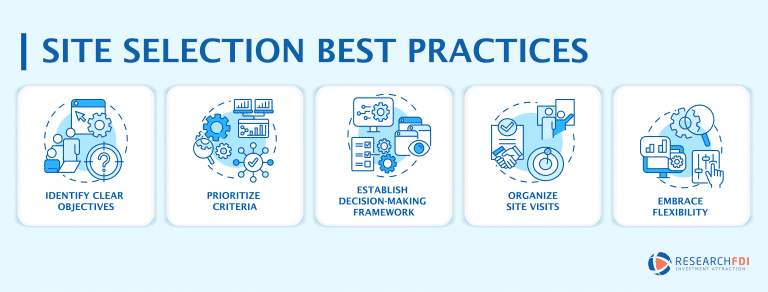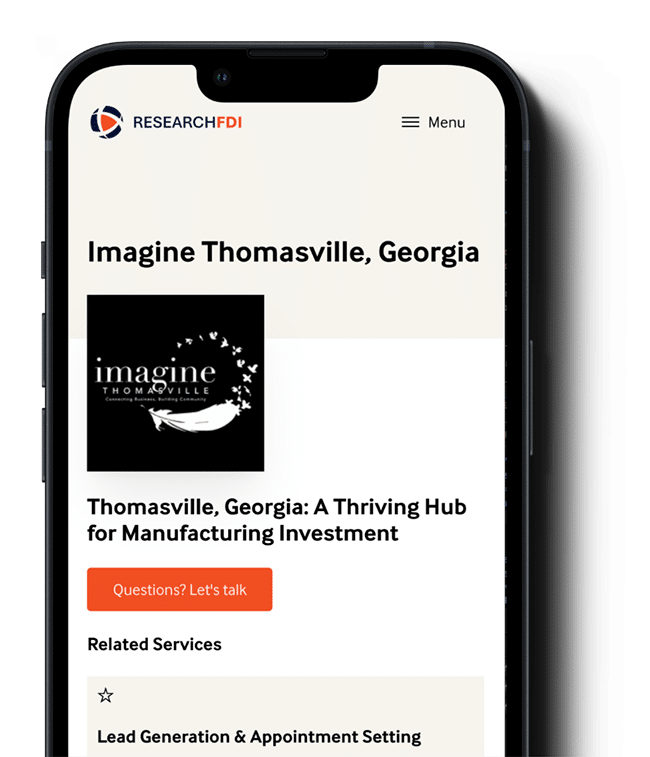As we progress further into our mini-series, we delve into the complex realm of site selection, building on the foundational elements discussed in Part 1: Choosing the Perfect Spot: How Site Selection Powers Economic Development.
Comprehending the site selection process requires a deep understanding of the various factors that contribute to the suitability of a location. In this installment of our mini-series, we examine the core principles and best practices that govern site selection. Our exploration uncovers key considerations involved in the process, while also revealing strategies and insights to enable informed, tactical decision-making in your site selection journey.
Site Selection Principles: Key Considerations When Choosing a Location
Site selection involves choosing the most appropriate location for a project to maximize its chances of success and contribute positively to the local economy. Although deciding factors vary depending on the project type and industry, several key principles apply universally to the site selection process. These principles ensure objective analysis of multiple factors leading to informed decision-making perfectly aligned with the project’s predefined goals and objectives.
Efficient Accessibility and Transportation:
A location’s proximity to essential transportation infrastructure such as highways, railways, ports, and airports, substantially influences the efficiency of transporting goods and personnel. Easy access to major transportation hubs can reduce logistical costs and improve market accessibility.
Labor Force and Talent Availability:
The availability of a skilled and trainable workforce is essential. A site should be located near a labor pool with the necessary skills and a range of wage levels to meet the needs of the project. Labor cost, which can noticeably vary across regions, should also be a major factor in the evaluation.
Reliable Infrastructure and Utilities:
Adequate infrastructure, including reliable power, water, sewage, and telecommunications services, is vital for most businesses. A site should have access to these utilities or the potential for their development. Further, the potential costs involved in establishing new connections or upgrades should be assessed.
Business Operation Costs:
While labor and utilities form significant operating costs, there are other expenditures such as land costs, lease expenses, taxes, and miscellaneous operational outlays that significantly influence a company’s profitability. A favorable business climate with competitive costs is often a key consideration. Compare the total cost of doing business in different locations to make an informed decision.
Regulatory Environment:
Understanding the local regulatory and permitting processes is essential. It is key to ensure that a prospective site is zoned for the intended use and can support the needs of the project. Furthermore, establishing a clear understanding of the local zoning regulations and permitting processes aids in identifying any restrictions that may impact the operations of a project.
Incentives and Support Programs:
Governments and local authorities often offer incentives to attract businesses, such as tax breaks, grants, or subsidies. Access to such incentives and support programs can be a key factor in site selection and should be considered when selecting a location. Various incentives and support programs can significantly impact the cost of business and the success of a project, as such, it is important to compare the incentives in different perspective locations.
Quality of Life:
Various lifestyle factors including education, healthcare, housing, and recreation influence an employee’s or executive’s decision to relocate. Furthermore, a favorable quality of life for employees can make it easier to recruit and retain talent.
Risk Assessment:
Potential risk factors such as natural disasters, political instability, or economic downturns should be identified and evaluated for each potential location. While examining these risk factors, it’s vital to devise a risk mitigation strategy. This strategy, which could include insurance, contingency plans, or diversification, will help manage and mitigate these potential threats to ensure stability. A comparison of the risk factors weighed against the risk mitigation for different locations is key to understanding the common risks and outliers when selecting the lowest risk location.
Competitive Analysis:
Evaluating the competitive landscape in the chosen area will aid in better understating the potential for a project’s success in a potential location. An in-depth understanding of similar businesses, their market share, pricing strategies, and consumer base helps in recognizing potential competition and differentiating strategies.
Growth Potential:
When choosing a location, it is key to understand the long-term goals of the project and compare those goals to the potential for growth at the potential site and greater region. Considering factors like available land or building space is key when evaluating whether the location can accommodate the project’s long-term growth and expansion plans.
Site Selection Best Practices: Empowering Informed Decision-Making
The long-term viability and success of any project primarily depend on making informed decisions throughout the site selection process. As such, best practices in site selection involve a comprehensive approach that takes into consideration a range of factors that empower informed decision-making. The long-term viability and success of any project primarily depend on making informed decisions throughout the site selection process.

Identify Clear Objectives:
Understanding the precise objectives and project requirements helps optimize the site selection. This could include factors like cost-effectiveness, access to markets, or specific infrastructure needs. Furthermore, in order to ensure that your site selection decisions are guided by long-term viability in a location it is crucial that your objectives consider both the short-term and the long-term goals of your project.
Prioritize Criteria:
Creating a set of priority-based criteria reflecting project needs can help highlight pivotal aspects influencing project success. The criteria, dependent on the project’s objectives, should symbolize the factors most likely to influence location choice. These might include low costs, access to transportation, workforce availability, and favorable regulatory environment.
Establish Decision-Making Framework:
Constructing a coherent decision-making framework considering all project criteria and collected data allows for an objective comparison and ranking of potential sites. This framework helps understand why a particular location surpasses others, offering valuable insights into project requirements, and assures the selection of the best site.
Organize Site Visits:
Site visits, a cornerstone of the site selection process, offer insights beyond remote analysis, revealing the condition of existing infrastructure and local community dynamics. Site visits provide hands-on opportunities that allow you to better understand your prospective location firsthand.
Embrace Flexibility:
While defining clear objectives and recognizing pivotal criteria is important in the site selection process, remaining adaptable to emerging information and insights is crucial. Being open to changes in criteria and priorities allows the project to embrace opportunities for growth rather than being confined by rigid requirements.
Influencing Decision-Making: Site Selection Principles and Best Practices in Action
Site selection is a dynamic and multifaceted process. Understanding the principles and best practices empowers stakeholders to make well-informed, strategic choices that are key to unlocking the full potential of their project’s success.
When diving into the site selection process, it is crucial that you allow yourself to be guided by the principles and best practices that underpin effective site selection, emphasizing the importance of informed decision-making.
Stay tuned for the third and final installment of this series, where we will look at the site selection process in action, exploring how the principles and best practices laid out in this article influence the different steps of the site selection process.
More from ResearchFDI:




